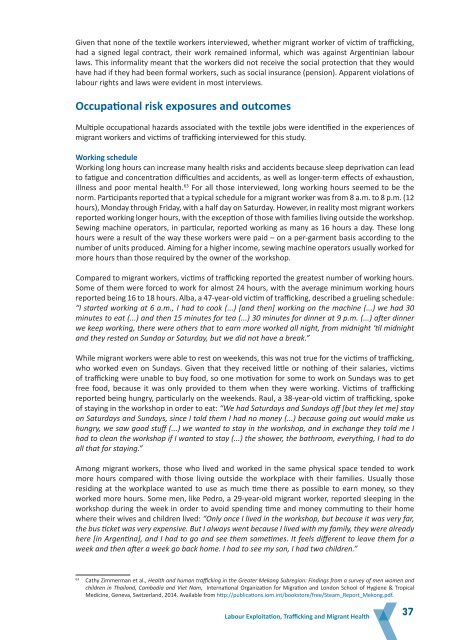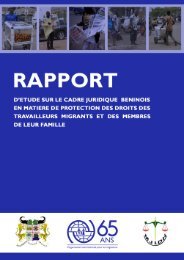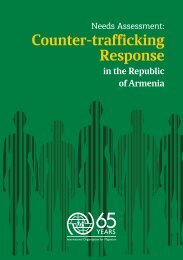Labour Exploitation Trafficking and Migrant Health
labour_exploitation_trafficking_en_0
labour_exploitation_trafficking_en_0
You also want an ePaper? Increase the reach of your titles
YUMPU automatically turns print PDFs into web optimized ePapers that Google loves.
Given that none of the textile workers interviewed, whether migrant worker of victim of trafficking,<br />
had a signed legal contract, their work remained informal, which was against Argentinian labour<br />
laws. This informality meant that the workers did not receive the social protection that they would<br />
have had if they had been formal workers, such as social insurance (pension). Apparent violations of<br />
labour rights <strong>and</strong> laws were evident in most interviews.<br />
Occupational risk exposures <strong>and</strong> outcomes<br />
Multiple occupational hazards associated with the textile jobs were identified in the experiences of<br />
migrant workers <strong>and</strong> victims of trafficking interviewed for this study.<br />
Working schedule<br />
Working long hours can increase many health risks <strong>and</strong> accidents because sleep deprivation can lead<br />
to fatigue <strong>and</strong> concentration difficulties <strong>and</strong> accidents, as well as longer-term effects of exhaustion,<br />
illness <strong>and</strong> poor mental health. 63 For all those interviewed, long working hours seemed to be the<br />
norm. Participants reported that a typical schedule for a migrant worker was from 8 a.m. to 8 p.m. (12<br />
hours), Monday through Friday, with a half day on Saturday. However, in reality most migrant workers<br />
reported working longer hours, with the exception of those with families living outside the workshop.<br />
Sewing machine operators, in particular, reported working as many as 16 hours a day. These long<br />
hours were a result of the way these workers were paid – on a per-garment basis according to the<br />
number of units produced. Aiming for a higher income, sewing machine operators usually worked for<br />
more hours than those required by the owner of the workshop.<br />
Compared to migrant workers, victims of trafficking reported the greatest number of working hours.<br />
Some of them were forced to work for almost 24 hours, with the average minimum working hours<br />
reported being 16 to 18 hours. Alba, a 47-year-old victim of trafficking, described a grueling schedule:<br />
“I started working at 6 a.m., I had to cook (...) [<strong>and</strong> then] working on the machine (...) we had 30<br />
minutes to eat (...) <strong>and</strong> then 15 minutes for tea (...) 30 minutes for dinner at 9 p.m. (...) after dinner<br />
we keep working, there were others that to earn more worked all night, from midnight ‘til midnight<br />
<strong>and</strong> they rested on Sunday or Saturday, but we did not have a break.”<br />
While migrant workers were able to rest on weekends, this was not true for the victims of trafficking,<br />
who worked even on Sundays. Given that they received little or nothing of their salaries, victims<br />
of trafficking were unable to buy food, so one motivation for some to work on Sundays was to get<br />
free food, because it was only provided to them when they were working. Victims of trafficking<br />
reported being hungry, particularly on the weekends. Raul, a 38-year-old victim of trafficking, spoke<br />
of staying in the workshop in order to eat: “We had Saturdays <strong>and</strong> Sundays off [but they let me] stay<br />
on Saturdays <strong>and</strong> Sundays, since I told them I had no money (...) because going out would make us<br />
hungry, we saw good stuff (...) we wanted to stay in the workshop, <strong>and</strong> in exchange they told me I<br />
had to clean the workshop if I wanted to stay (...) the shower, the bathroom, everything, I had to do<br />
all that for staying.”<br />
Among migrant workers, those who lived <strong>and</strong> worked in the same physical space tended to work<br />
more hours compared with those living outside the workplace with their families. Usually those<br />
residing at the workplace wanted to use as much time there as possible to earn money, so they<br />
worked more hours. Some men, like Pedro, a 29-year-old migrant worker, reported sleeping in the<br />
workshop during the week in order to avoid spending time <strong>and</strong> money commuting to their home<br />
where their wives <strong>and</strong> children lived: “Only once I lived in the workshop, but because it was very far,<br />
the bus ticket was very expensive. But I always went because I lived with my family, they were already<br />
here [in Argentina], <strong>and</strong> I had to go <strong>and</strong> see them sometimes. It feels different to leave them for a<br />
week <strong>and</strong> then after a week go back home. I had to see my son, I had two children.”<br />
63<br />
Cathy Zimmerman et al., <strong>Health</strong> <strong>and</strong> human trafficking in the Greater Mekong Subregion: Findings from a survey of men women <strong>and</strong><br />
children in Thail<strong>and</strong>, Cambodia <strong>and</strong> Viet Nam, International Organization for Migration <strong>and</strong> London School of Hygiene & Tropical<br />
Medicine, Geneva, Switzerl<strong>and</strong>, 2014. Available from http://publications.iom.int/bookstore/free/Steam_Report_Mekong.pdf.<br />
<strong>Labour</strong> <strong>Exploitation</strong>, <strong>Trafficking</strong> <strong>and</strong> <strong>Migrant</strong> <strong>Health</strong><br />
37





